Die 10 häufigsten Fehler beim Testen von Kabeln, die zu vermeiden sind
5. Juni 2025 / Allgemeines, Installation und Tests, Aufrüsten und Fehlerbehebung
Die intelligenten Prüfer, die Netzwerkkabelsysteme installieren, testen und zertifizieren, verstehen, wie wichtig die Einhaltung standardmäßiger Leistungsparameter und die Bereitstellung von Support hinsichtlich aller Anwendungen sind, jedoch begehen selbst die Besten Fehler, die sowohl das Geschäftsergebnis als auch die Kundenzufriedenheit beeinträchtigen können. Hier sind die 10 häufigsten Fehler, die Sie beim Testen von Netzwerkverkabelungssystemen vermeiden sollten.
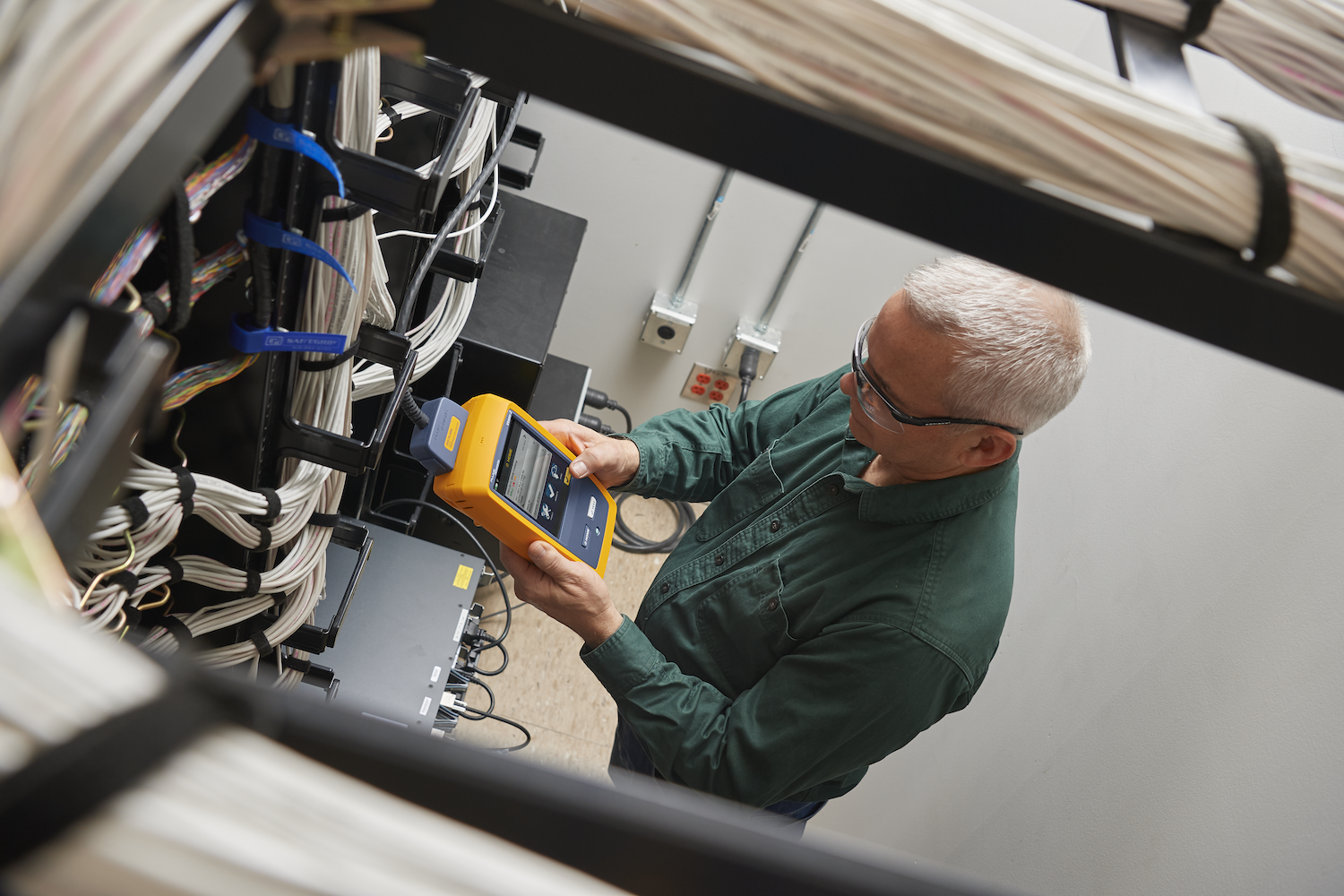
1: Versäumnis, sich auf Testparameter zu einigen
Für die Zertifizierung einer Kupferverkabelungsanlage sind in Industrienormen wie ANSI/TIA-568.2 und ISO/IEC 11801 grundlegende Leistungsparameter festgelegt, darunter:
- • Einfügedämpfung (IL)
- • Return Loss (RL) (Rückflussdämpfung)
- • Near-End Crosstalk (Nahnebensprechen, NEXT) und Far-End Crosstalk (Fernnebensprechen, FEXT) gemessen
- • Für Kategorie 6A ist außerdem das Testen von Alien Crosstalk erforderlich, da dies ein wichtiger Leistungsparameter ist, der die Funktionsfähigkeit von 10GBASE-T beeinträchtigen kann.
Feldprüfung kann zusätzliche optionale Gleichgewichtsparameter umfassen.
- • DC Widerstandsunsymmetrie berechnet den Unterschied im Gleichstromwiderstand zwischen den Leitern innerhalb eines Paares und zwischen den Paaren, was die Unterstützung von Power over Ethernet (PoE) anzeigt.
- • Transverse Conversion Loss (TCL) und Equal Level TCL (ELTCTL) messen das Gleichtaktsignal innerhalb eines Paares und zeigen die richtige Balance für die Störfestigkeit an (einschließlich Alien Crosstalk).
Der Standardtestgrenzwert eines DSX CableAnalyzer™-Zertifizierungstesters ist (+PoE), was die DC Widerstandsunsymmetrie einschließt. Wenn Sie die Testgrenze (+Alle) wählen, werden die Parameter TCL und ELTCTL hinzugefügt.
Für die Zertifizierung eines Kupfersystems ist es technisch erforderlich, die in den Industriestandards für die Anwendung festgelegten Parameter zu testen, einschließlich Alien Crosstalk für Kategorie 6A. Die Parameter, auf die Sie letztendlich prüfen, hängen jedoch von den Projektspezifikationen Ihres Kunden ab — unabhängig davon, was die Standards besagen oder was Branchenexperten empfehlen. Wenn die Spezifikation eine Kabelanlagengarantie vorschreibt, müssen Sie auch die von Ihrem Kabelhersteller geforderten Parameter testen.
Sie sollten den Zeit- und Kostenaufwand für die erneute Prüfung von Parametern unbedingt vermeiden, die Sie beim ersten Mal vernachlässigt haben. Deshalb ist es wichtig, sich mit dem Kunden und dem Kabelhersteller zu verständigen, um alle Testparameter im Voraus zu vereinbaren. Es hilft Ihnen auch, die Projektkosten abzuschätzen und sich auf die Aufgabe vorzubereiten. Dazu gehört auch, dass Sie sich vergewissern, dass Ihr Testgerät alle angegebenen Parameter prüfen kann, insbesondere neuere wie DC Widerstandsunsymmetrie, TCL und ELTCTL. Glücklicherweise können diese Parameter mit einem Fluke Networks DSX CableAnalyzer™ Zertifizierungstester getestet werden.

Eine vorherige Vereinbarung über den Test gilt auch für die Faserprüfung. Stellen Sie sicher, dass Sie, Ihr Kunde und der Hersteller der Verkabelung sich über die Durchführung von Tier-1- oder Tier 2-Fasertests einig sind, damit Sie wissen, ob Sie zusätzlich zu Ihrem Optical Loss Test Set (OLTS) ein Optical Time Domain Reflectometer (OTDR) benötigen.
- • Die Tier-1-Prüfung mit einem OLTS bietet die genaueste Messung der Einfügungsdämpfung über die Länge einer Glasfaserverbindung und ist in den Industriestandards vorgeschrieben.
- • Bei einem Tier-2-Test mit einem OTDR handelt es sich um eine erweiterte Prüfung, bei der die Einfügedämpfung und das Reflexionsvermögen einzelner Spleiße und Stecker entlang der Glasfaserverbindung charakterisiert werden. Beachten Sie, dass die Verwendung eines OLTS auch dann erforderlich ist, wenn Sie und Ihr Kunde sich auf einen Tier-2Test geeinigt haben, um die Konformität der Anwendung sicherzustellen, da es die Gesamteinfügungsdämpfung genau misst.
2: Keine Einigung über marginale Testergebnisse
Als Installateur hoffen Sie, dass jeder Test für normenkonforme Kabel ein positives Ergebnis liefert. Allerdings kann alles, von den Installationspraktiken bis hin zur Qualität der Komponenten und des Testgeräts, ausreichen, um die Testergebnisse einer Verbindung in den Grenzbereich zu verschieben, in dem das Ergebnis näher an der Testgrenze liegt als die vom Hersteller des Feldtestgeräts angegebene Genauigkeit. Nach den TIA- und ISO/IEC-Standards gilt jedes knappe Bestehen immer noch als bestanden und konform. In den Standards ist auch ausdrücklich festgelegt, dass marginale Testergebnisse für einen Parameter mit einem Sternchen (*) gekennzeichnet werden müssen. Dies zeigt deutlich, dass die Genauigkeit des Testers eine Rolle spielt.
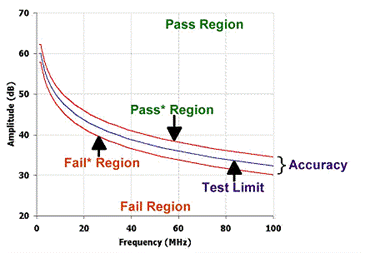
Durch die Auswahl eines Industrie-konformen Testers wie den Fluke Networks Versiv™ Kabelzertifizierer, der wiederholbare, außergewöhnliche Genauigkeit bietet, können marginale Testergebnisse minimiert werden. Jeder Tester, der es Ihnen erlaubt, das Sternchen zu deaktivieren und marginale Ergebnisse auszublenden, ist nicht konform — ganz zu schweigen davon, dass er Ihren Ruf und Ihr Unternehmen gefährden kann. Darüber hinaus müssen Sie darauf achten, Ihren Tester in Tip Top Zustand zu halten –mit der neuesten Firmware, Wartung und Kalibrierung Schritt zu halten, Ihren Tester nach Bedarf zu warten und sicher zu stellen, dass Ihre permanent-Link-Adapter nicht abgenutzt sind.
Trotz aller Bemühungen werden marginale Durchläufe geschehen, vor allem dann, wenn der Link eine Querverbindung oder einen Konsolidierungs-Punkt enthält, der eine weitere Verbindung hinzufügt. Einige Kunden können es ablehnen, einen marginalen Durchlauf zu akzeptieren, und wundern sich, was mit ihrem vermeintlichen erstklassigen Verkabelungssystem geschah. Dies ist der Fall, wenn Sie sicherstellen möchten, dass Sie abgesichert sind. Denken Sie daran, was die Standards besagen: Wenn es nicht angegeben und schriftlich vereinbart wurde, dass marginale Testergebnisse nicht akzeptabel sind, sind Ihre marginalen Durchläufe immer noch gültig. Eine Einigung auf marginale Testergebnisse im Voraus ist ein kluger Schachzug.
3: Improvisieren bei einem Alien Crosstalk Test
Während die Projektspezifikation Ihres Kunden und/oder die Garantieanforderungen des Herstellers Ihre Testparameter bestimmen, ist die Wahrscheinlichkeit groß, dass Sie für jede Kategorie 6A-Installation, einschließlich PS ANEXT und PS AACR-F, einen Alien Crosstalk-Test durchführen müssen. Es ist die einzige Möglichkeit, die Konformität für 10GBASE-T-Anwendungen nachzuweisen, und die meisten Verkabelungshersteller gewähren ohne dieses Zertifikat keine Systemgarantie.
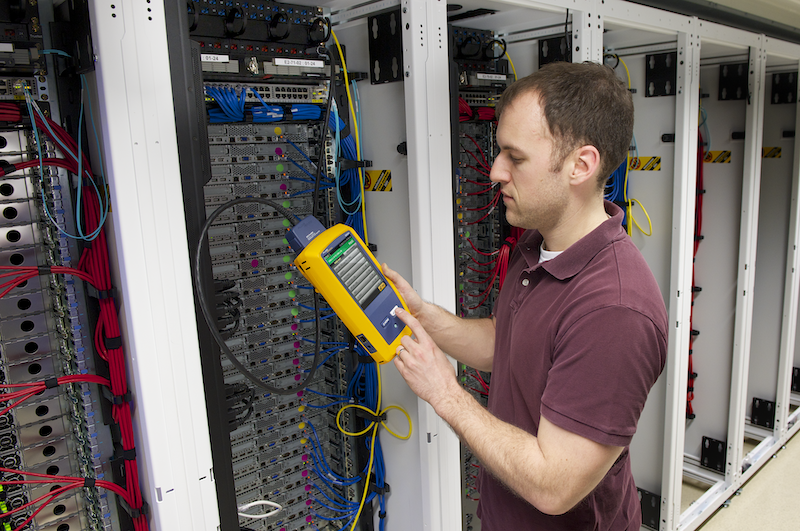
Sie sind nur dann von den Alien Crosstalk-Tests befreit, wenn diese nicht vorgegeben sind und der Kunde und der Verkabelungsanbieter sich darauf einigen, nicht darauf zu testen. Während Sie sich wahrscheinlich denken, „Aber es ist nicht wirtschaftlich möglich oder praktikabel, alle Links auf Alien Crosstalk-Kompatibilität testen?“, aber machen Sie sich da keine Sorgen. Die Industriestandards erlauben es Ihnen, eine Stichprobengröße für Alien Crosstalk-Tests anhand der in der Tabelle aufgeführten Empfehlungen festzulegen. Der Standard empfiehlt, eine gleiche Anzahl von kurzen, mittleren und langen gestörten Verbindungen zu testen. Er besagt auch, dass die Prüfung abgebrochen werden kann, wenn drei dieser gestörten Verbindungen eine Spanne von 5 dB überschreiten.
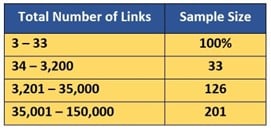
Empfohlene Stichprobengrößen für Alien Crosstalk-Tests
Wählen Sie bei der Auswahl der gestörten Verbindungen nicht diejenigen aus, die am Ende einer Reihe von Verbindern enden — dies ist nicht der ungünstigste Fall. Der gestörte Link sollte oben und unten von Verbindern umgeben sein. Stellen Sie jedoch sicher, dass die Störer im gleichen Bündel sind — Alien Crosstalk zwischen Kabelbündeln gilt nicht als bedeutend.
Abgeschirmte Kabel bieten im Vergleich zu ungeschirmten Kabeln eine weitaus höhere Störfestigkeit und sollten kaum Alien Crosstalk aufweisen. Eine offene (nicht angeschlossene) Abschirmung eines abgeschirmten Kabels kann jedoch zu einem nicht bestandenen Alien Crosstalk-Test führen. Dies kann durch eine unsachgemäße Installation der Abschirmung verursacht werden, wie Anklemmen der nicht leitenden Seite der Folie im Kabel. Während die meisten Tester nach einer einfachen Kontinuität zwischen der Abschirmung am Hauptgerät und der Abschirmung am Vor-Ort-Gerät suchen, wird dieses Signal nach jeder Möglichkeit suchen, um an das Vor-Ort-Gerät zu gelangen — auch über die gemeinsame Gebäudeerde, an die die Patchfelder und Racks angeschlossen sind. Das bedeutet, dass der Tester eine angeschlossene Abschirmung anzeigen wird, auch wenn sie offen ist. Sie können diese Situation DSX CableAnalyzer™ Zertifizierungstester vermeiden, der Probleme der Distanz-/Abschirmungsintegrität mit einer patentierten Messtechnik meldet.
Wenn Sie immer noch denken, dass Sie beim Alien Crosstalk-Testen improvisieren können, überlegen Sie es noch mal. Wenn dies in der Spezifikation oder für die Garantie erforderlich ist, müssen Sie eine Stichprobengröße gemäß den Empfehlungen der Standards angeben —unabhängig davon, ob die Verkabelung abgeschirmt ist oder nicht. Wenn Sie das nicht tun, riskieren Sie, jede Verbindung auf Alien Crosstalk testen zu müssen, was ein sehr kostspieliges Versäumnis ist.
4: Testen des Kanals statt der permanenten Verbindung
In einem Netzwerk verbindet der Kanal ein aktives Gerät zu einem anderen, einschließlich aller Patchkabel und Gerätekabel. Dies von einem Zugriffs-Switch zu einem Server im Rechenzentrum sein, einschließlich Patchkabeln an Querverbindungen oder Zusammenschaltungen. Im LAN könnte dies der Weg von einem Zugangs-Switch in einem Telekommunikationsraum zu einem Laptop, einer Kamera, einem Wi-Fi-Zugangspunkt oder einem anderen Gerät sein, einschließlich des Patchkabels vom Switch zum Patchfeld und des Gerätekabels von der Stromquelle zum Gerät. Industriestandards begrenzen die Gesamtlänge eines Kanals auf 100 Meter, einschließlich bis zu 90 Meter Verkabelung und höchstens 10 Meter Patchkabel.
Die permanente Verbindung ist der feste Teil des Kanals bis zu 90 Meter. Es besteht in der Regel aus einem Kabel von einem Patchfeld zu einem anderen Patchfeld im Rechenzentrum oder von einem Patchfeld zu einem Arbeitsbereichsausgang oder Konsolidierungspunkt im LAN.

Eine ordnungsgemäße Datenübertragung hängt von der Leistung des Kanals ab, da er die komplette End-to-End-Verbindung bildet, über die die aktiven Geräte im Netz kommunizieren. Es scheint intuitiv, dass Kanalprüfung zweifellos die richtige Vorgehensweise wäre, oder? Falsch.
Gemäß den Industriestandards führt die Verwendung von konformen Patchkabeln mit einer konformen permanenten Verbindung immer zu einem passablen Kanal. Wenn Sie den Kanal jedoch nur mit sehr hochwertigen Patchkabeln testen, können Probleme mit der permanenten Verbindung unentdeckt bleiben, und der Kanal könnte zu einem späteren Zeitpunkt nicht richtig funktionieren. Wenn ein Netzwerk erst einmal in Betrieb ist, werden Patchkabel häufig umverlegt oder im Zusammenhang mit der Neukonfiguration von Geräten ausgetauscht. Sie werden auch mehr als jede andere Komponente gehandhabt und bearbeitet, daher sind sie auch schadensanfälliger. Aus diesem Grund werden Patchkabel oft als „schwächstes Glied“ im Kanal bezeichnet. Wenn Sie einen Kanal zunächst mit hochwertigen Patchkabeln testen und später eines dieser Patchkabel beschädigt oder durch ein minderwertiges ersetzt wird, besteht der Kanal möglicherweise nicht mehr. Daher ist es wichtig, die permanente Verbindung zu testen — sie ist das eigentliche Fundament des Netzwerks. Es sollte immer ein durchgehender Kanal vorhanden sein, solange Sie hochwertige, normgerechte Patchkabel zu einer durchgehenden permanenten Verbindung hinzufügen.
Das ist einer der Gründe, warum die Adapter für permanente Verbindungen, die mit den DSX CableAnalyzer-Testern geliefert werden, von höchster Qualität sind — sie vermeiden nachteilige Auswirkungen auf die zu prüfende permanente Verbindung und gewährleisten letztlich die Interoperabilität mit konformen Patchkabeln.
5: Testen eines MPTL mit den falschen Adaptern
Bei einem MTPL (Modular Plug Terminated Link) handelt es sich um eine direkte Anschlussmethode wobei ein horizontales Kabel, das an einem Ende in einen Stecker mündet, der direkt in ein Geräte eingesteckt wird. Industriestandards erkennen diese Konfiguration als Option für den Anschluss von Geräten an, bei denen es unpraktisch oder nicht sicher ist, eine Steckdose und ein Gerätekabel zu verwenden. Es ist auch ideal für Geräte, die normalerweise nicht bewegt werden müssen, wie PoE-Lampen und Überwachungskameras.
Mit einem MTPL, der direkt an ein Gerät angeschlossen wird, haben Sie keinen typischen Kanal mit vier Anschlüssen mehr, den Sie als Verbindung mit zwei permanenten Link-Adaptern testen würden. Sie sollten jedoch auch sicherstellen, dass Sie die Leistung des feldkonfektionierten Steckers am fernen Ende überprüfen können. Einige Prüftechniker haben einen Channel Adapter am fernen Ende verwendet, aber dies schließt die Steckverbindung am fernen Ende von dem Test aus, was zu optimistischen Ergebnissen führt und möglicherweise Probleme mit dem feldkonfektionierten Stecker übersehen lässt. Sie riskieren eine nicht funktionierende Verbindung, nachdem das Kabel in ein Gerät eingesteckt wird.
Stattdessen verlangen die Industriestandards einen Permanent-Link-Adapter am nahen Ende und einen Patchkabeladapter am fernen Ende, wie in der Abbildung dargestellt. Dadurch wird sichergestellt, dass die Leistung des feldkonfektionierten Steckers in Ihre Ergebnisse einfließt. Fluke Networks liefert mit dem DSX CableAnalyzer Adapter für permanente Verbindungen einen Adapter für ein einzelnes Patchkabel, um dies zu erleichtern. Wählen Sie einfach MPTL für die Test-Limits auf Ihrem Tester.
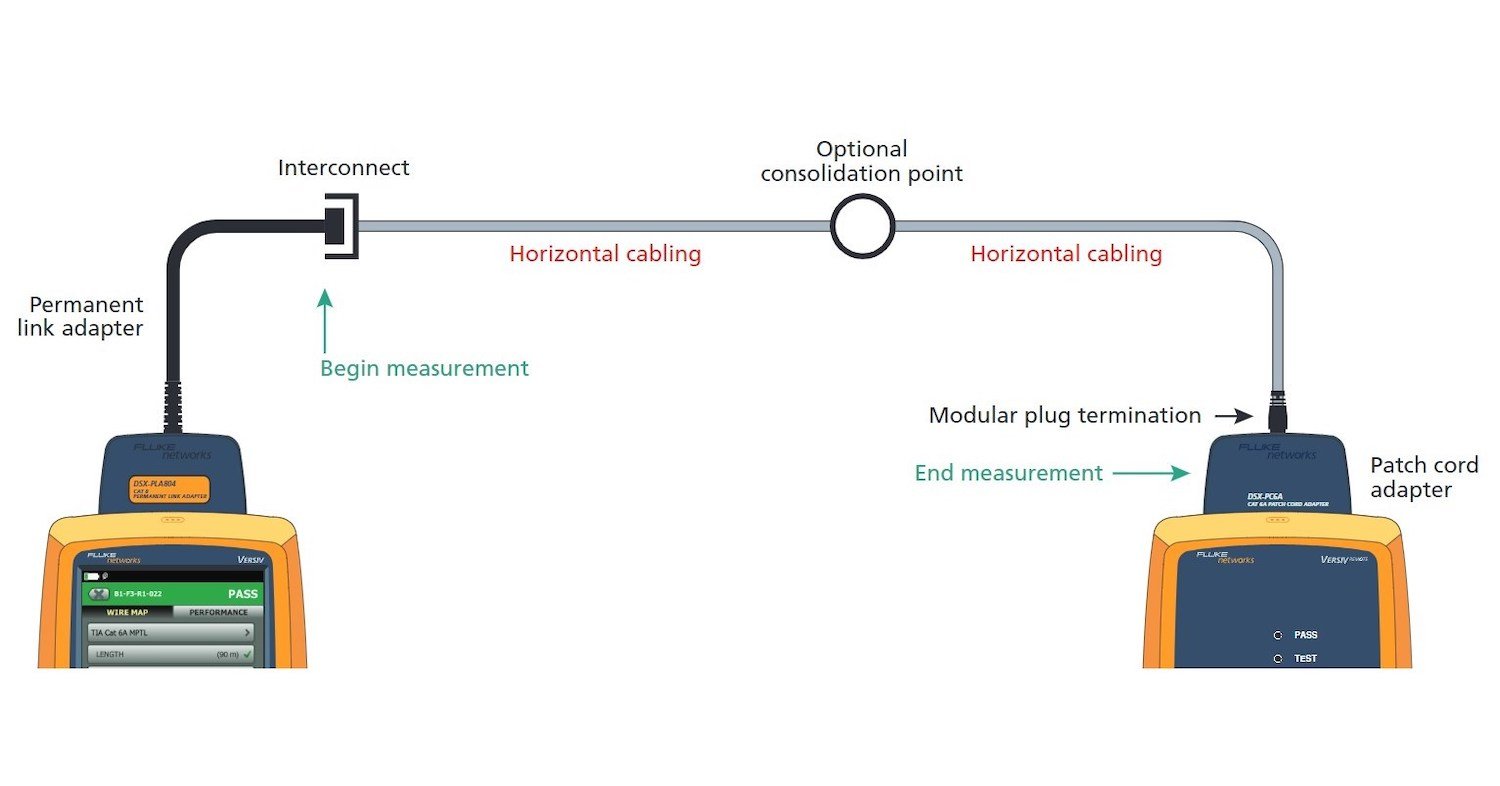
6: Vergessene Aktivierung der Plotdaten für Ihre Testergebnisse
Plot-Daten sind die grafische Farbdarstellung von gemessenen Testparametern, die für Zertifizierungsprüfungen erforderlich sind. Für die Kupferzertifizierung enthalten die Plotdaten Diagramme für die wichtigsten Parameter, einschließlich Einfügedämpfung (IL), Rückflussdämpfung (RL), Nebensprechen am nahen und fernen Ende (NEXT, PSNEXT, PSACRN, ACRF, PSACRF) und Alien Crosstalk (PS ANEXT und PS AACR-F). Jedes Diagramm zeigt Dezibel (dB) auf der Y-Achse und die Frequenz auf der X-Achse. Die Frequenz variiert je nach der Art der getesteten Verkabelung: bis zu 100 MHz für Kategorie 5e, 250 MHz für Kategorie 6, und 500 MHz für Kategorie 6A. Beachten Sie dabei, dass Sie auch die Frequenz erweitern können, was für das Neuzertifizieren eines Kabels auf einen höheren Standard praktisch sein kann.
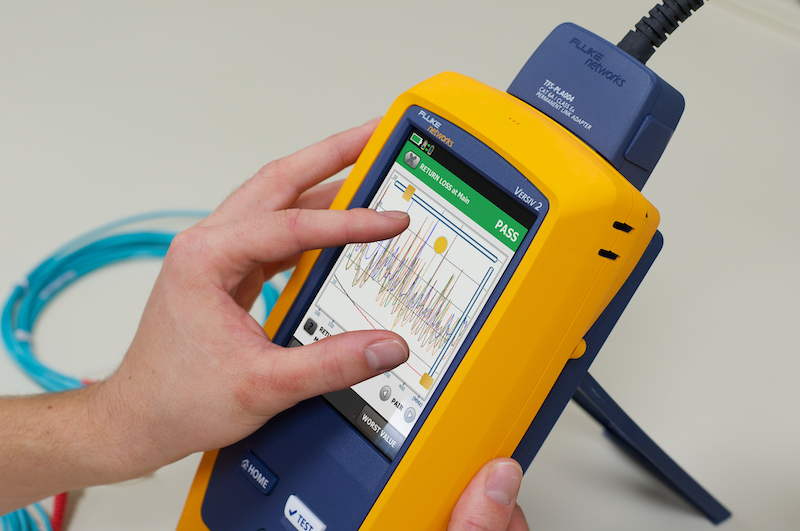
Für jedes Diagramm zeigt die glatte rote Linie die Testgrenzen des Standards, nach dem Sie testen wollen (d. h., TIA, ISO/IEC). Die zackigen Farblinien zeigen die Ergebnisse für einzelne Paare und Paarkombinationen. Diese Zeilen sind zackig, da die tatsächlichen Ergebnisse in der Regel Höhen und Tiefen haben, das ist kein Problem, solange sie über der Grenze bleiben.

Es ist wichtig, Plotdaten zu ermöglichen, da sie in der Regel für Zertifizierungstests erforderlich sind und wertvolle visuelle Informationen über die Leistung einzelner Paare innerhalb des Kabels liefern. Es ist auch die einzige Möglichkeit, wirklich zu diagnostizieren, was ein Problem mit der zu prüfenden Verbindung verursachen könnte, da Sie erkennen können, wo das Nebensprechen auftritt. Sie müssen auch die Plotdaten mit Ihrem DSX CableAnalyzer-Tester aktivieren, um die Parameter HDTDX (High Definition Time Domain Crosstalk) und HDTDR (High Definition Time Domain Reflectometry) einzuschließen, die Zeitbereichsinformationen anzeigen, um die Stelle auf der zu prüfenden Verbindung anzugeben, an der das Nebensprechen oder die Rückflussdämpfung zu hoch ist.
Plotdaten sind auch wichtig, wenn Sie Fluke Networks Support bei der Fehlersuche benötigen. Wenn Sie keine Plotdaten für die Analyse durch unsere technischen Experten zur Verfügung haben, werden wir Sie bitten, den Test mit aktivierten Plotdaten zu wiederholen, wodurch sich Ihre Testzeit verdoppelt. Erfreulicherweise ist die Standardeinstellung für den DSX CableAnalyzer Zertifizierungstester die Anzeige und Speicherung von Plotdaten für frequenzbasierte Tests, die für den ausgewählten Testgrenzwert erforderlich sind. Als Mindestanforderung wird empfohlen, diese Einstellung zu behalten. Durch die Auswahl von „Erweitert“ werden Daten über den Frequenzbereich der gewählten Test-Grenzwert hinaus gespeichert. Ihr Kunde wird es natürlich auch schätzen, die Kopffreiheit dargestellt zu bekommen – Berichte ohne Plot-Daten werden leer aussehen.
7: Das Auslassen einer genauen Glasfaserprüfung und -reinigung
Trotz ständiger Erinnerungen und Aufklärung über die Bedeutung der Inspektion von Glasfaserendflächen sind kontaminierte Verbindungen nach wie vor die Hauptursache für Probleme und Ausfälle in Glasfasernetzen. Ob an einem Glasfaser-Cross-Connect, einem Geräteanschluss oder am Ende eines Überbrückers, überall dort, wo sich eine freiliegende Glasfaserendfläche befindet, besteht die Gefahr, dass der Faserkern verunreinigt wird und sich Partikel darauf befinden, die zu Verlusten und Reflexionen führen können. Wenn Sie es versäumen oder einfach vergessen, die Glasfasern vor dem endgültigen Anschluss ordnungsgemäß zu prüfen und zu reinigen, kann dies den Unterschied ausmachen, ob Sie mit einem zufriedenen Kunden zum nächsten Auftrag übergehen oder ob Sie zusätzliche Zeit (und Geld) aufwenden müssen, um ein Problem zu beheben.
Bei der Inspektion von Faserendflächen kann man sich nicht mit einer schnellen manuellen Inspektion mit einem Fasermikroskop zufrieden geben. Ihr Erfahrungsgrad, die Umgebungsbeleuchtung, Ihr Sehvermögen und sogar Ihre Eile oder Müdigkeit können sich auf Ihre Fähigkeit auswirken, eine Faserendfläche genau zu prüfen.
Die gute Nachricht ist, dass es einen Standard für die Faserprüfung gibt, der dazu beiträgt, den Prozess zu rationalisieren und jegliche menschliche Subjektivität zu beseitigen. Der IEC 61300-3-35-Standard für Basistest- und Messverfahren für faseroptische Verbindungselemente und passive Komponenten bietet einen empfohlenen Reinigungs- und Inspektionsprozess, der spezifische Kriterien für die Sauberkeitseinstufung anhand der Anzahl und Größe von Kratzern und Defekten in den kritischen Kern- und Mantelbereichen einer Faserendfläche umfasst. Die Einhaltung dieses Standards kann dazu beitragen, einen unnötigen und kostspieligen Austausch von Kabeln und/oder Geräten zu vermeiden.

Eine noch bessere Nachricht ist, dass die Faserprüfgeräte von Fluke Networks ein automatisches PASS/FAIL auf Basis des IEC 61300-3-35 Standards bieten.
8: Keine Verwendung der Ein-Jumper-Referenz für Tier-1-Fasertests
Bei Tier-1-Fasertests bezieht sich der Verbindungsverlust auf den Verlust eines zusammengesteckten Steckerpaares. Es ist praktisch unmöglich, den Verlust eines einzelnen Verbinders zu messen. Beim Testen einer permanenten Glasfaserverbindung, z. B. von einem Patchfeld zu einem anderen, sollte der Verlust sowohl des ersten als auch des letzten Steckers berücksichtigt werden, da die Verkabelungsanlage auf diese Weise genutzt wird. Um den Verlust dieser Steckverbinder zu messen, müssen sie mit Hilfe von Testreferenzkabeln (TRCs) mit einem Steckverbinder ähnlicher Qualität verbunden werden.
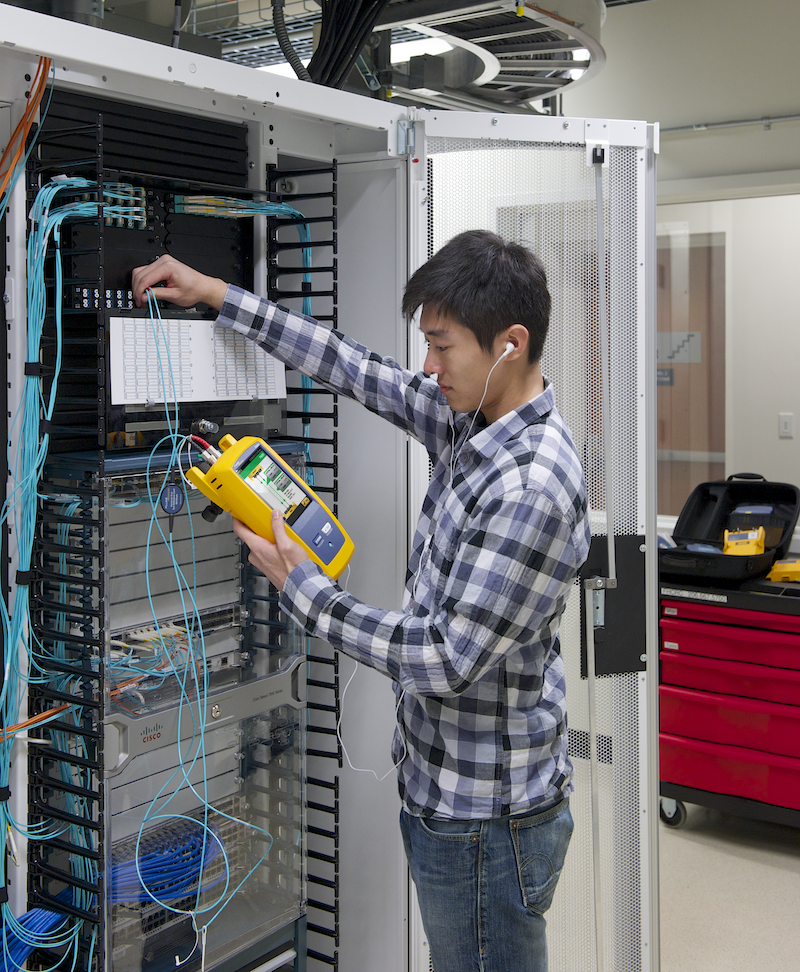
Bei der Verwendung eines TRC muss der Tester den Verlust des TRC berücksichtigen, indem er eine Referenz einstellt. Das ist so ähnlich, als würde man eine Schüssel auf eine Waage stellen und dann die Waage auf Null kalibrieren, um genau zu wiegen, was in die Schüssel gegeben wird. Industriestandards empfehlen die Verwendung der Ein-Jumper-Referenzmethode, um eine Referenz zu setzen. Dadurch kann der Test den Verlust der Verbindungen an beiden Enden des Kanals einschließen. Da der Großteil der Dämpfung in einem Kanal von diesen Verbindungen verursacht wird, wird mit der Einkabel-Referenzmethode die höchste Genauigkeit erzielt.
Eine Referenz mit zwei Jumpern scheint zwar sinnvoller zu sein, doch wird dabei die Verbindung zwischen den beiden Jumpern nicht berücksichtigt und letztlich nur eine Endverbindung in die Verlustmessung einbezogen. Es bildet den Gesamtverlust nur teilweise ab und kann zu übermäßig optimistischen oder sogar negativen Verlustergebnissen führen. Ein solche durch eine von einer Zweikabel-Referenz verursachte negative Dämpfung resultiert in einer Warnung und einem FAIL auf dem Fluke Networks CertiFiber Pro® Optical Loss Test Set. Außerdem werden viele Kabelanbieter Ergebnisse ablehnen, die mit einer Zweikabel-Referenz erzielt wurden, und das könnte verhindern, dass Sie eine Garantie erhalten.
Beim Einstellen der Referenz bietet das CertiFiber Pro Testgerät einen Assistenten zum Einstellen der Referenz, der Sie mit Hilfe einer Animation Schritt für Schritt durch den Prozess führt. Es zeigt Ihnen genau, wie Sie Ihre TRCs an Ihre Haupt- und Nebenstellen anschließen. Sobald die Referenz eingestellt ist, führt der Assistent Sie durch das Trennen der TRCs von den Eingangsanschlüssen.
9: Verwendung des falschen Referenzkabels für Fasertests
Verwenden Sie bei der Zertifizierung einer Glasfaserkabelanlage nur die von Ihrem Prüfgerätehersteller empfohlenen TRCs. Echte TRCs, wie sie von Fluke Networks angeboten werden, bestehen aus Kabeln und Verbindern in Referenzqualität mit einem sehr geringen Verlust von weniger als 0,1 dB für Multimode und 0,2 dB für Singlemode. Alles andere als ein echter TRC könnte zu falschen Ausfällen führen – die Auswirkungen auf Ihr Endergebnis können Sie weit mehr kosten als alles, was Sie durch den Kauf eines billigen Ersatzprodukts sparen. Stellen Sie sich vor, Sie müssten eine Glasfaserverbindung neu installieren, die bestanden hätte, wenn Sie von vornherein die empfohlenen TRCs verwendet hätten.
Unabhängig davon, welche TRCs Sie verwenden, ist es die beste Praxis, die Leistung Ihrer TRCs zu überprüfen, bevor Sie mit den Tests beginnen. Es zeigt Ihnen, dass der Ausfall einer Verbindung nicht durch schlechte TRCs verursacht wurde. Wir empfehlen, Ihre TRCs bei jedem 288 Test zu überprüfen und die Ergebnisse zu dokumentieren, damit Sie einen Anhaltspunkt haben, um festzustellen, ob Ihre TRCs abgenutzt sind und ersetzt werden müssen. Der CertiFiber Pro Testgerät-Assistent führt Sie schrittweise durch den Prozess der Verifizierung Ihrer TRCs.
Es ist auch wichtig, die richtige Art von TRC zu verwenden. Für Multimode-Fasern verlangen die Industriestandards die Prüfung des eingekreisten Flusses (EF), der den Einführungsbedingungen der heutigen Glasfasertransceiver besser entspricht. Die EF-Prüfung verringert die Messunsicherheit, verhindert zu optimistische Ergebnisse und wird von den Verkabelungsherstellern verlangt, um eine Garantie zu erhalten. Für Multimode-Tests benötigen Sie ein EF-konformes Testgerät, wie das CertiFiber Pro OLTS, zusammen mit EF-konformen TRCs.
Obwohl die EF-Prüfung den Standards entspricht und die bewährte Praxis ist, sollten Sie, wenn Sie immer noch einen gewöhnlichen Messdorn verwenden, um die Startbedingungen zu kontrollieren und die Genauigkeit durch das Entfernen von Moden höherer Ordnung zu verbessern, Ihren TRCs große Aufmerksamkeit widmen. Wenn Sie Abstriche machen und herkömmliche Kabel verwenden, können diese aus biegeunempfindlicher Multimodefaser (BIMMF) bestehen. Da BIMMF engere Biegungen mit wesentlich weniger Signalverlust standhält, werden bei Verwendung von BIMMF- Testkabeln in Verbindung mit einem Messdorn die Moden höherer Ordnung nicht entfernt. Die Industriestandards besagen sogar, dass in allen Prüfkabeln kein BIMMF verwendet werden sollte – selbst wenn die zu prüfende Verbindung BIMMF verwendet. Die EF-Prüfung mit unseren EF-TRCs ohne BIMMF ist eine weitaus genauere Methode zur Prüfung von Multimode-Fasern, weshalb sie von den Industriestandards gefordert wird.
10: Verlass auf einen Duplex-Tester zum Zertifizieren von MPO-Kabeln
Die meisten Hochgeschwindigkeits- 100 bis 800 Gigabit-Glasfaserverbindungen in Rechenzentren basieren auf MPO-Steckverbinderlösungen (Multi-Fiber Push-On). Nur durch Feldversuche kann sichergestellt werden, dass die MPO-Faser den Leistungsanforderungen der Anwendung entspricht. Es scheint nur logisch zu sein, dass das Testen eines Mehrfaser-MPO-Faser-Links mit einem Duplex-Tester zeitaufwändig wäre. Das Testen einer 12-Faser-MPO-Verbindung mit einem Duplex-Testgerät verlangt tatsächlich 15 Schritte mit einer Drei-Jumpermethode und der Verwendung von MPO zu LC-Fanout-Kabel oder verlustarmen MPO-LC-Kassetten, die das 12-Glasfaserkabel in einzelne Glasfaserkanäle trennt.
Zum Testen der MPOs mit einem Duplex-Testgerät müssen Sie zuerst die SC-LC- und LC-LC-Test-Referenzkabel überprüfen und einrichten. Ein drittes LC-Test-Referenzkabel muss dann überprüft, eingerichtet und entfernt werden, bevor das erste Paar von Fasern auf den MPOs angeschlossen wird – und es müssen noch fünf weitere Paare an beiden Enden getestet werden. Dieser komplexe, zeitaufwändige Prozess birgt das Potenzial für größere Inkonsistenzen und macht es schwieriger, alle Anschlüsse während des Prozesses sauber zu halten.

Tester mit einem integrierten MPO-Stecker nehmen Komplexität, Zeit und Inkonsistenz aus dem MPO-Testen, wodurch die Notwendigkeit für Fanout-Kabel oder -Kassette entfällt. Das Fluke Networks MultiFiber™ Pro optische Leistungsmessgerät bietet diese Funktionalität und ermöglicht das gleichzeitige Scannen aller Fasern und die Anzeige der Testergebnisse in einem leicht lesbaren Balkendiagramm. Der MultiFiber Pro kann jede Faser des MPO zu identifizieren, was präzisere, pro-Faser-Daten und Berichterstattung zur Verbesserung der MPO Connector-Überprüfung und -Fehlerbehebung ermöglicht. Es kann sogar die korrekte Polarität prüfen, wodurch eine durchgehende Verbindung vom Sender zum Empfänger gewährleistet wird. Die Messung der Polarität mit dem MultiFiber Pro erlaubt es Ihnen, einzelne Patch-Kabel sowie ständige Verbindungen und Kanäle auf ihre korrekte Polarität hin zu testen, ohne vorherige Kenntnis der Polarität der Verbindung.
Das nächste Mal, wenn Sie meinen, dass ein Duplex-Tester für den MPO-Test ausreichen wird, denken Sie daran, dass ein Tester mit einer integrierten MPO-Schnittstelle wie der MultiFiber Pro die Komplexität eliminiert und Sie 90 % schneller testen können.




